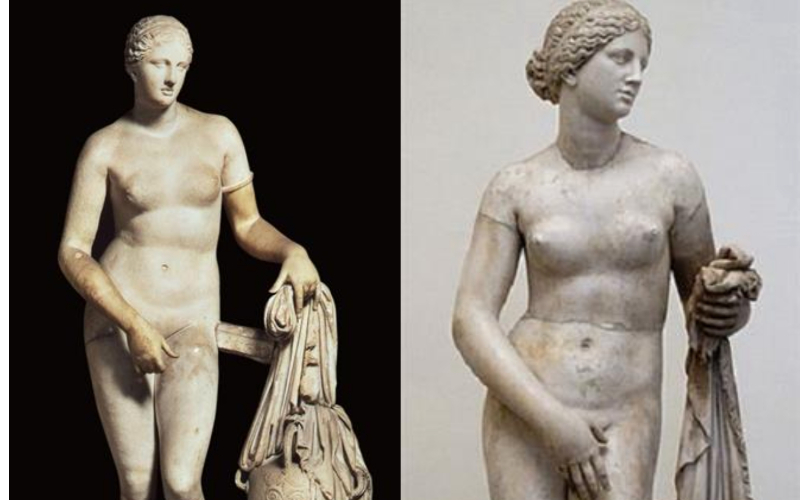Around the fourth century BC, Praxiteles of Athens sculpted the goddess Aphrodite as the Aphrodite of Knidos (or Cnidus).
One of the earliest life-size depictions of the nude female body in Greek history, it presents a different perspective on masculine heroic nudity.
Aphrodite as shown by Praxiteles is shown hiding her pubis while reaching for a bath towel, leaving her breasts uncovered.
Male nude figures had dominated Greek sculpture up until this moment. Although the Greek sculpture’s original form is no longer extant, numerous Roman copies of this important piece of art still exist.
The Venus de’ Medici and the Capitoline Venus are variations of the Venus Pudica, which denotes an action to hide the breasts.
The cult statue for the Knidos Temple of Aphrodite was the Aphrodite of Knidos. The goddess Aphrodite was shown removing her robes with one hand while modestly securing herself with the other as she got ready for the ritual bath that would restore her purity.
Her hands are in a position that conceals her pubic region while highlighting her bare upper body. The statue is renowned for its beauty and is made to be admired from all angles.
The original can only be broadly described because different copies depict different body shapes, poses, and accessories.
The body is bending in a contrapposto position, a Greek artistic innovation that accurately depicts a typical human stance, with the head likely turned to the left.
She “wore a slight smile that just revealed her teeth,” according to Lucian, while the majority of later versions do not retain this.
The first nude female figures in Greek sculpture, known as kore, didn’t appear until nearly three centuries after their nude male counterparts, the kouros.
The Colonna Knidia, located in the Vatican’s Pio-Clementine Museum, is widely regarded as the best copy of The Aphrodite of Knidos, which established a canon for the proportions of the naked female.
It is believed to be a Roman copy and to fall short of the polished elegance of the original, which was destroyed in a catastrophic fire at Constantinople in CE 475. Aphrodite was sculpted by Praxiteles in both a nude and a draped form, according to Pliny the Elder.
While the city of Knidos bought the nude sculpture, the city of Kos bought the draped version because they thought the nude version was unpleasant and reflected poorly on their city. According to Pliny, Knidos became famous because of the statue. Knidos-issued coins with images of the statue appear to support this assertion.
The rumor surrounding the statue’s creation included a claim that Praxiteles employed the courtesan Phryne as a model.
Aphrodite herself reportedly visited Knidos to witness the statue because it was so well-known and frequently imitated.


